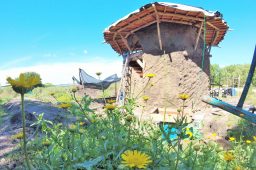Uruguay – hidden treasure of Latin America
- March 31, 2017
- by
- Milica Radović
Uruguay is a magical country, a country of freedom. Its population is 3 million and a half of it lives in Montevideo. Situated between Argentina and Brazil, it rests on the seaside.

Natalia, a friend of mine I met last year in Israel, is a former history teacher and a current social worker. She talked a lot about her life in Uruguay. She says that compared to other countries, there is not a lot of corruption in Uruguay, or that there is very little of it. She thinks that life standard in Uruguay is pretty high, and that everyone can find a job after graduating. What I found refreshing is talking to someone satisfied about their life in Uruguay. Although it is not all rainbows and butterflies, Natalia does not live a posh life and she is happy.
 Natalia and me in montevideo
Natalia and me in montevideo
I was surprised that everyone heard about Serbia because of Novak Đoković and the history of non-aligned countries in the time of Tito.
What I found absolutely crazy about Uruguay are its freedoms that Mujica initiated. Mujica’s story is miraculous because he is a visionary and a revolutionst. He is said to have been very important since he left a very meaningful message to Uruguay, although people who worked with him were not in accordance with his values. During Mujica’s term of office, abortion was legalized, as well as cannabis and same-sex marriage. It was a great honour to have met Mujica and I wrote about that at this link.
 Pepe Mujica and myself in his vineyard
Pepe Mujica and myself in his vineyard
Freedoms of Uruguay
The fact that the abortion has been legalized is of great importance and 97% of women in Latin and Central America live in the countries where the abortion is prohibited. Abortion is now being considered as an option in this part of the world because of the zika virus, but they are still far from legalizing it.
Same-sex marriage has been legalized so in Montevideo you can see a lot of gay couples that came from abroad in order to live in peace. I find it quite sad that people have to flee to other countries in order to be who they truly are. However, if you have to go to Uruguay in order to be who you truly are, that is bad, at all. 🙂
 Hostel in Uruguay – Cabo di Polognio
Hostel in Uruguay – Cabo di Polognio
Cannabis has been legalized which means that everyone on the street can smoke pot just like the cigarettes. You are only not allowed to smoke weed in the restaurant, so you have to go outside. Cannabis is so omnipresent that everyone smoke it in the parks, they walk down the streets while smoking, pass by the police station with a joint in their hands. I found it fascinating that we all live on the same planet but still have very different rules. In Uruguay marijuana is legalized, while in Serbia you would be arrested and locked up for at least three years.
I had a chance to smoke weed with one girl and her mother in a restaurant in the open. They grow their own plants at home. It is interesting that in bigger cities you can see the old and the young smoking pot. There are clubs where cannabis is grown in large quantities monthly. You pay a monthly fee in order to, at the end of the month, get a certain amount of marijuana grown in a professional way.
 Growing cannabis in home conditions
Growing cannabis in home conditions
The trick is that you cannot buy cannabis in stores, you have to grow it yourself. Local shops dedicated to cannabis will give you some as a gift if you buy something. That is a grey area. But they say that it will be legalized soon. If you go to a park and ask someone for it, they will give it to you for free or a small amount of money because it exists in abundance.
 Cannabis shop in Montevideo
Cannabis shop in Montevideo
There is also a cannabis museum where you can hear about its history and many purposes it serves. I was in that museum in Montevideo and it is nothing special, just a sensational story.
I feel bad that I did not have enough time to go to the hostel called THC that revolves around cannabis, not far from Montevideo. My friend went there and says that swimming in a pool next to which cannabis is being grown is an amazing experience.
Four things that Uruguay has in common with its neighbouring countries:
- Mate tea – is a coffee substitute since it has a large amount of caffeine. History of this tea dates back to the indigenous people from Brazil. There are several kinds of mate tea preparation- with hot or cold water, etc. What I found interesting is its way of preparation. A mixture of tea that makes up mate tea is served in a special mug that is made of yields from the tree Calabash. That yield is made into a mug that is additionally decorated and looks something like this:

Every other person in Uruguay walks around with a thermos of hot water and a mug full of mate tea. I still do not realize how they do not find it hard to walk around with something in their hands. It is huge, and everyone does it. That is how I was able to differentiate between people from Brazil and Argentina from those from Uruguay. 🙂
 Picture taken from the link
Picture taken from the link
- Shoes with a huge platform – for some reason, girls in Latin America adore wearing platform shoes. We do not talk about high heels, which they rarely wear, but about shoes with a huge platform. It is possible that that is because of girls being very short. This is a thing in Uruguay and Argentina.

Platform shoes
- Trashcan is not on the ground – It was very interesting to see trashcans in Brazil, Uruguay and Argentina that are located in front of their gates but not on the concrete but are a meter or two above the ground. Maybe it is because they don’t want the dogs to scatter trash around.

- Dulce de leche – When I first tried dulce de leche, or in other words, sweetened milk, I thought that it was some kind of a bad tasting peanut butter. Every house had at least a kilogram of dulce de leche and they often used it as marmalade substitute. It consists of regular milk, condensed milk, vanilla and sugar. It tastes of caramel.

Climate and tourism
In Uruguay the best weather is from October until May. Average temperature is a little above 20 degrees and it does not feel humid at all as it is the case in Asia. In this pictrure you can see the average lowest and highest temperatures in Uruguay throughout the whole year.

Picture taken from the link.
Although I was in Uruguay in January during the peak of the season, there are not a lot of tourists in Montevideo. They are all on the seaside. Although Montevideo is a very cute city with a sea access, tourism is not very developed. Having a sea access means erecting residential builidings with a sea view. In these parts you will not find tourist shops, but rather a typical residential area.
 Buidlings on the Montevideo coast
Buidlings on the Montevideo coast
Tourists are usually concentrated around four cities depending on their interests. Colonia del Sacramento gathers typical tourists interested in history, while posh tourism is predominant in Punta Del Este where all the luxurious resorts are located. Middle-class hipsters and hippies go to Punta Del Diabolo that is located on the Brazilian border, while hard core hippies go to Cabo de Polonio.
Out of all places in Uruguay, Cabo de Polonio is a real discovery. A guy from a tattoo shop suggested that I go visit it. Cabo de Polonio amazed me because of a few reasons. There are no roads leading to it and it is 10 km away from the main road. You can reach it by walking or vans that go regularly. In this photo you can see a wonderful city of Cabo de Polonio- tucked between green dunes that guard it from the chaos on one side, and vast see, on the other.


A van that takes you to Cabo de Polonio
This place has about hundred houses that do not have fences, but are all in the open, like a huge comune.
What is special about Cabo de Polonio is that it does not have electricity nor water system. What I found very interesting is the fact that people who come there are predominantly tourists from Brazil and Uruguay. Rarely will you bump into an odd traveller like myself. Atmosphere is magical, especially during the night when every café and restaurant light their candles and light a fire in the middle of their gardens around which singing and friendly people gather. This place made me feel so safe that I decided to sleep on the grass in my sleeping bag. Everybody acts like a huge family.
One disadvantage about Uruguay is they have a monotonous cuisine. Lovers of meat and barbeque will be full, and those who want to eat diverse food and vegetables will surely remain hungry. Besides meat, they serve seafood which is usually imported from Chille. I was also bothered by the fact that things in Uruguay are quite expensive, especially the food.
This is my overall impression of Uruguay from the tourist point of view. In the next blog post I will show you the side of Uruguay tourists rarely have a chance to see.




![[VIDEO] Rafting in Bosnia](https://blog.themilica.com/wp-content/uploads/2017/06/Rafting-1-256x170.png)


